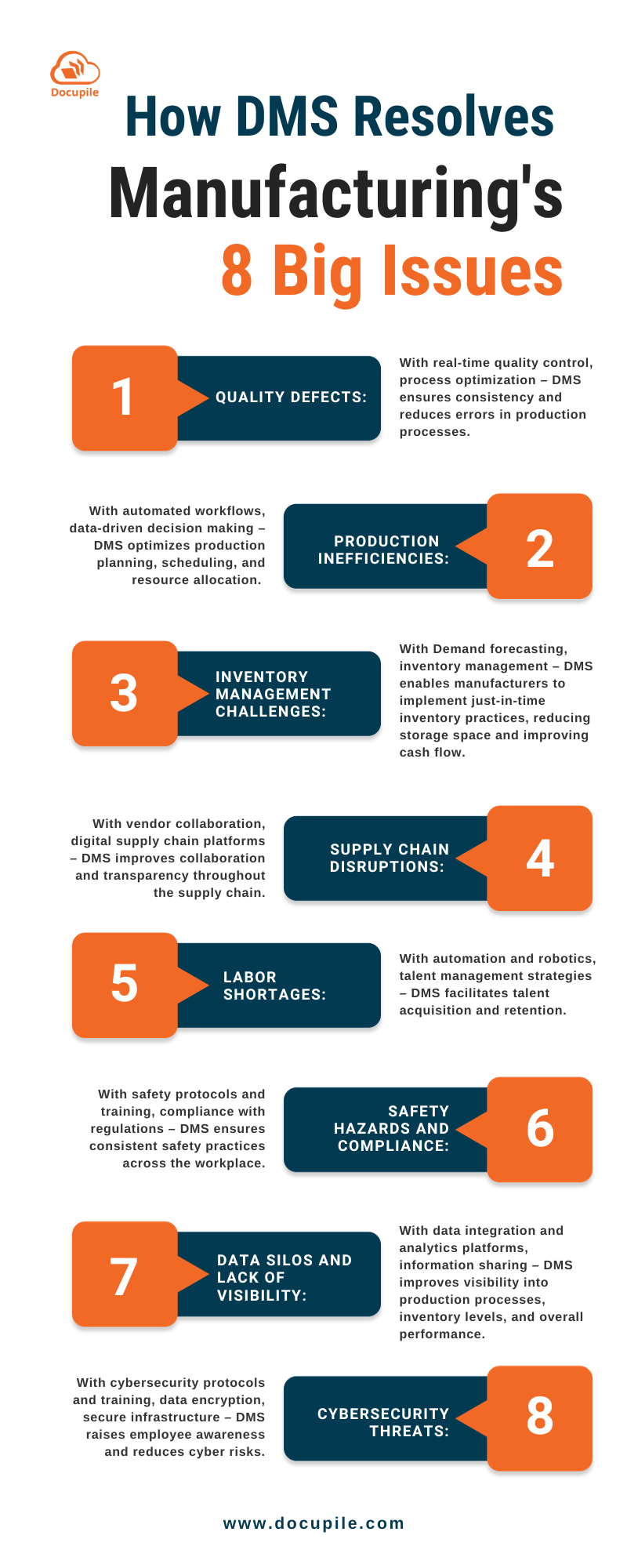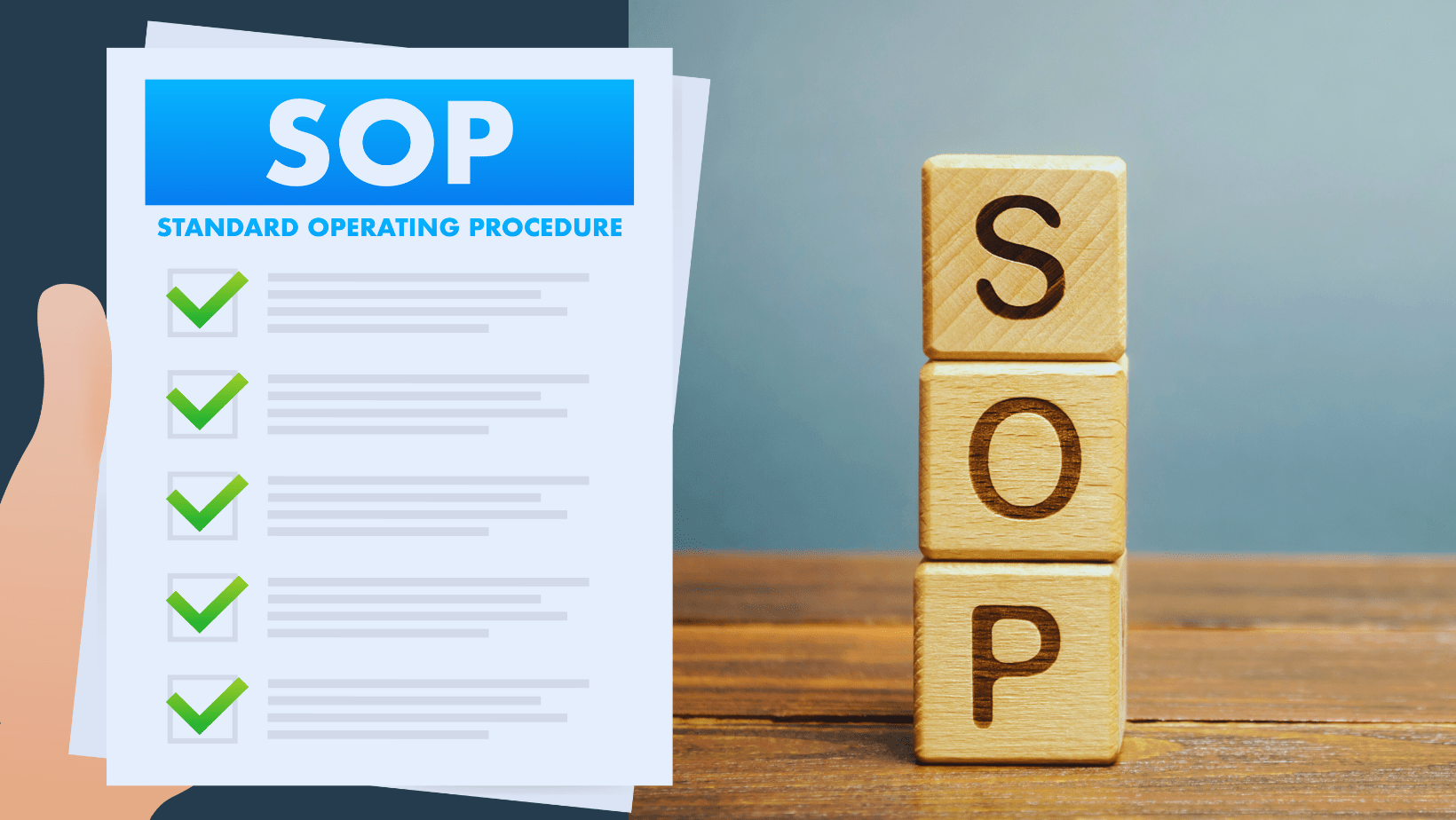Why Manufacturers Need DMS in Their Toolbox?
Manufacturers in today’s cutthroat environment cannot afford paper-based chaos and scattered digital documents. Implementing a Manufacturing Documentation Management System (MDMS) equips them with a powerful tool, streamlining workflows, boosting efficiency, and securing a competitive edge. Imagine centralizing all drawings, specs, SOPs, and quality control records in one secure, accessible platform. No more wasted time searching for files or working with outdated versions. Foster seamless collaboration across departments and locations with secure document sharing and annotation. This translates to quicker decision-making, fewer errors, and faster time to market. But the benefits extend beyond operational efficiency.
Manufacturing Document Management Software empowers manufacturers to address critical challenges like quality defects, production inefficiencies, and regulatory compliance. Real-time quality control data helps identify and rectify issues early, minimizing waste and rework. Compliance becomes a breeze with centralized regulations, automated document approval, and comprehensive audit trials. Ultimately, a DMS isn’t just software; it’s a game-changer, let’s explore further into this topic.
Overview:
Infographic:

Digitization and Manufacturing Documentation Management
A Powerful Competitive Advantage
In today’s fast-paced and competitive manufacturing landscape – digitization and effective document management software are no longer optional – they’re essential for success. Implementing a Manufacturing Documentation Management System (MDMS) offers a multitude of benefits that translate directly into competitive advantages for your business. Here’s why:
Enhanced Efficiency and Productivity:
- Centralized Document Repository: Say goodbye to paper mountains and scattered files. An MDMS provides a single, secure platform for storing all your manufacturing documents, including drawings, specifications, work instructions, and quality control records. This eliminates time wasted searching for documents and ensures everyone is working with the latest versions.
- Improved Collaboration: Secure document sharing and annotation features allow teams to collaborate seamlessly across departments and locations, fostering better communication and faster decision-making.
Boosted Quality and Compliance:
- Standardized Procedures: Ensure consistent quality by storing and accessing standardized operating procedures (SOPs) easily. MDMS can track changes and enforce compliance, minimizing the risk of human error.
- Simplified Compliance: Streamline compliance with industry regulations and internal quality standards by managing relevant documents and audit trails efficiently.
Increased Agility and Adaptability:
- Data-Driven Decision Making: Gain valuable insights into your production processes by analyzing data from various sources within the MDMS. This data-driven approach allows you to identify bottlenecks, optimize processes, and adapt quickly to changing market demands.
- Remote Operations and Scalability: Cloud-based MDMS solutions enable remote access to documents and data, facilitating flexible work arrangements and collaboration across geographically dispersed teams. This also allows you to scale your operations easily as your business grows.
How DMS Resolves Manufacturing’s Big Issues?

DMS, or Documentation Management Software, can play a significant role in addressing various challenges faced by the manufacturing industry. Here’s how Manufacturing Document Management Software can help resolve some of the big issues:
1. Quality Defects:
- Real-time quality control: By centralizing and digitizing quality control documents, DMS enables real-time tracking and analysis of production data. This allows for early identification and correction of defects, reducing waste and rework.
- Process optimization: Standardized procedures and best practices can be easily accessed and shared through DMS, ensuring consistency and reducing errors in production processes.
2. Production Inefficiencies:
- Automated workflows: Repetitive tasks like document approvals, routing, and data entry can be automated using DMS workflows, freeing up employee time for more productive activities.
- Data-driven decision making: DMS provides a centralized repository for production data, facilitating analysis and insights for optimizing production planning, scheduling, and resource allocation.
3. Inventory Management Challenges:
- Demand forecasting: Sales and production data stored in DMS can be used for accurate demand forecasting, reducing the risk of overstocking or understocking inventory.
- Just-in-time inventory: By providing real-time visibility into inventory levels and supplier lead times, DMS enables manufacturers to implement just-in-time inventory practices, reducing storage space and improving cash flow.
4. Supply Chain Disruptions:
- Vendor collaboration: DMS can facilitate secure document sharing and communication with suppliers, improving collaboration and transparency throughout the supply chain.
- Digital supply chain platforms: Integrating DMS with digital supply chain platforms can provide real-time visibility into supplier activities, shipments, and potential disruptions.
5. Labor Shortages and Skills Gaps:
- Automation and robotics: DMS can support the integration of automation and robotics solutions by managing technical documentation, maintenance records, and training materials.
- Talent management strategies: DMS can facilitate talent acquisition and retention by storing employee records, performance evaluations, and career development plans.
6. Safety Hazards and Compliance:
- Safety protocols and training: Safety manuals, procedures, and training records can be easily accessed and updated through DMS, ensuring consistent safety practices across the workplace.
- Compliance with regulations: DMS can help manufacturers comply with environmental regulations by storing and managing relevant permits, certifications, and audit reports.
7. Data Silos and Lack of Visibility:
- Data integration and analytics platforms: DMS can integrate with various data sources and provide real-time dashboards and reports, improving visibility into production processes, inventory levels, and overall performance.
- Information sharing: Secure document sharing and access control features in DMS enable seamless collaboration and information sharing across departments, breaking down data silos.
8. Cybersecurity Threats:
- Cybersecurity protocols and training: Cybersecurity policies, procedures, and training materials can be managed and distributed through DMS, raising employee awareness and reducing cyber risks.
- Data encryption: DMS systems typically employ data encryption and access control measures to protect sensitive manufacturing data from unauthorized access.
- Secure infrastructure: Secure cloud storage and disaster recovery solutions offered by DMS providers can further enhance data security and minimize downtime in case of cyberattacks.
Overall, DMS can be a valuable tool for manufacturers looking to address various challenges and improve operational efficiency.
Speeding Up Time to Market in Manufacturing with a DMS

Time to market (TTM) is a critical metric in manufacturing, representing the time it takes to bring a new product from concept to customer hands. A slow TTM can mean lost revenue, missed market opportunities, and a competitive disadvantage. Here’s how a Documentation Management System (DMS) can be a powerful tool for accelerating TTM in your manufacturing operations:
1. Streamlining Design and Development Processes:
- Centralized Design Repository: Store and manage all design files, specifications, and technical documents in a single, secure location. This eliminates time wasted searching for files and ensures everyone involved has access to the latest versions.
- Version Control and Change Management: Track changes made to documents and easily revert to previous versions if needed. This reduces the risk of errors and rework, speeding up the design and development process.
- Improved Collaboration: Enable seamless collaboration between designers, engineers, and other stakeholders through secure document sharing. This facilitates faster decision-making and reduces delays.
2. Efficient Regulatory Compliance and Documentation:
- Automated Document Generation and Approval: Automate the generation and approval of standard operating procedures (SOPs) and other critical documents based on pre-defined workflows. This reduces the time spent on manual document creation and approvals.
- Improved Traceability and Transparency: DMS facilitates complete traceability of materials, components, and production processes, simplifying audits and investigations. This can speed up regulatory approvals and market entry.
3. Enhanced Collaboration and Communication:
- Secure Document Sharing: Share documents securely with suppliers, partners, and external stakeholders, facilitating efficient collaboration and eliminating communication delays.
- Real-time Project Updates: Keep everyone informed of project progress and changes through real-time updates and notifications within the DMS. This ensures everyone is on the same page and avoids misunderstandings that can slow down progress.
Instant Access to Information: Fuels Processes in Manufacturing with a DMS

One of the most transformative aspects of a Documentation Management System (DMS) in manufacturing is the power of instant access to information. Let’s dive deeper into how:
1. Design and Development:
- Faster Decision-Making: Immediate access to design specifications, technical documents, and historical data empowers engineers and designers to make informed decisions quickly, accelerating the design and development process.
- Reduced Errors and Rework: Instant retrieval of the latest versions of documents eliminates the risk of working with outdated information, minimizing errors and costly rework.
- Enhanced Collaboration: Seamless sharing and annotation of documents across teams foster real-time collaboration and problem-solving, speeding up the design iteration process.
3. Procurement and Supplier Management:
- Streamlined Purchase Orders: Secure and instant access to specifications and contracts facilitates quick and accurate purchase order generation, improving communication and efficiency with suppliers.
- Enhanced Vendor Collaboration: Secure document sharing, and communication features foster closer collaboration with suppliers, allowing for faster resolution of issues and improved responsiveness to changes.
- Transparency and Traceability: Immediate access to audit trails and supplier certifications ensures compliance and provides complete traceability of materials and components.
4. Regulatory Compliance and Audits:
- Simplified Documentation Management: Centralized storage and access to all regulatory documents and certifications streamline compliance processes and reduce the risk of delays due to non-compliance.
- Improved Audit Preparation: Complete audit trails and instant access to relevant documents simplify audit preparation and reduce stress for compliance teams.
5. Knowledge Management and Continuous Improvement:
- Training and Onboarding: Easy access to training materials and knowledge bases facilitates faster onboarding of new employees and upskilling existing ones, contributing to improved operational efficiency.
- Data-Driven Decision Making: Instant access to production data facilitates informed decision-making, enabling manufacturers to identify areas for improvement and optimize processes for greater efficiency and profitability.
Ensuring SOP Conformity with a Manufacturing DMS

Maintaining Standard Operating Procedures (SOPs) is crucial in manufacturing for ensuring quality, consistency, and safety. Traditionally, paper-based SOPs were prone to errors, version control issues, and limited accessibility. However, with the rise of Manufacturing Documentation Management Systems (MDMS), manufacturers can now achieve a new level of SOP conformity.
What is SOP Conformity?
SOP conformity refers to the degree to which employees adhere to established procedures. High conformity leads to:
- Reduced errors and defects: Consistent execution of SOPs minimizes mistakes and ensures product quality.
- Improved efficiency and productivity: Streamlined processes save time and resources.
- Enhanced safety: Following safety protocols reduces accidents and injuries.
- Regulatory compliance: Adherence to SOPs helps manufacturers meet industry regulations and standards.
How can a DMS help achieve SOP conformity?
A Manufacturing Document Management Software offers several features that can significantly improve SOP conformity:
- Centralized repository: Store all SOPs in a single, secure location, accessible to authorized personnel from anywhere.
- Version control: Track changes made to SOPs and ensure everyone is working with the latest version.
- Search and filtering: Easily find specific SOPs based on keywords, categories, or other criteria.
- Training and knowledge management: Integrate training materials and knowledge bases with SOPs, facilitating employee learning and understanding.
- Analytics and reporting: Track SOP usage and identify areas for improvement.
Benefits of using a Manufacturing Document Management Software for SOP conformity:
- Reduced risk of non-compliance: Easy access to the latest SOPs and automated workflows minimize the risk of employees using outdated or incorrect procedures.
- Improved communication and collaboration: A central repository fosters better communication and collaboration around SOPs.
- Continuous improvement: Data-driven insights from analytics enable manufacturers to identify areas for improving SOPs and employee training.
- Reduced costs: Eliminating paper-based SOPs and automating tasks saves time and money.
Choosing the right DMS for SOP conformity:
When choosing a Document Control Software for Manufacturing, consider factors like:
- Scalability: Choose a system that can grow with your organization.
- Security: Ensure the system meets your data security requirements.
- Ease of use: The system should be user-friendly for all employees.
- Integration: Consider how the DMS integrates with your existing systems.
Implementing a Manufacturing Document Management Software for SOP conformity:
- Get buy-in from all stakeholders.
- Develop a clear implementation plan.
- Train employees on the new system.
- Monitor and measure progress.
DMS: The Backbone of Regulatory Compliance in Manufacturing

In the ever-evolving landscape of manufacturing, regulatory compliance is paramount. Ensuring adherence to a multitude of regulations is not just a legal obligation, but also crucial for maintaining product quality, consumer safety, and brand reputation. Here’s how manufacturing documentation management empowers manufacturers to navigate the complex world of regulatory compliance:
1. Centralized Repository:
- Eliminate paper chaos: Store all critical documents, including regulations, SOPs, certifications, and audit reports, in a single, secure, and accessible digital repository. This eliminates the risk of losing documents, working with outdated versions, or missing crucial information.
- Improved accessibility: Authorized personnel can access documents anytime, anywhere, from any device, ensuring everyone has the latest information at their fingertips. This facilitates timely decision-making and efficient compliance processes.
2. Version Control and Audit Trails:
- Maintain historical records: Track changes made to documents and ensure everyone is working with the latest approved version. This eliminates confusion and ensures consistency in compliance practices.
- Transparent audit trails: Maintain detailed audit trails for all document access and modifications, providing irrefutable proof of compliance during audits or investigations.
3. Enhanced Collaboration and Communication:
- Break down silos: Foster seamless collaboration between different departments, including production, quality control, and regulatory affairs, by providing a shared platform for document access and communication. This promotes a holistic approach to compliance.
- Real-time updates and feedback: Enable real-time document sharing and annotation, facilitating efficient feedback loops and ensuring everyone is on the same page regarding compliance requirements.
4. Data-Driven Insights and Reporting:
- Identify compliance gaps: Analyze data from document usage and audit trails to identify areas where compliance is weak or at risk. This allows for targeted interventions and continuous improvement of compliance practices.
- Generate comprehensive reports: Generate customized reports on compliance performance, including metrics like document access rates, training completion rates, and audit findings.
Crucial Features to Look for When Choosing a Manufacturing DMS

When choosing a Manufacturing Documentation Management System (MDMS) for your operation, the key features are about more than just storing files. You need a system that streamlines workflows, improves compliance, and empowers your team to work efficiently and effectively. Here are some crucial features to look for:
Secure, single platform: All your manufacturing documents, including drawings, specifications, SOPs, and quality control records, should be stored in a central, secure, and easily accessible location.
Version control: The system should track changes made to documents and ensure everyone has access to the latest approved versions.
Search and filtering: Easy search and filtering functionalities should help you quickly find specific documents based on keywords, categories, or other criteria.
Audit trail capabilities: Track all document access and modifications to provide a clear audit trail for regulatory compliance and investigations.
Reporting and analytics: Generate reports on compliance performance and document usage to identify areas for improvement and demonstrate your commitment to regulatory compliance.
Granular access control: Define different levels of access permissions for different users and groups to ensure sensitive documents are protected.
Data encryption and backups: The system should use industry-standard encryption and secure backup procedures to protect your valuable data from unauthorized access and loss.
Disaster recovery plan: A disaster recovery plan ensures that your documents are accessible even in the event of unexpected outages or system failures.
Scalable architecture: Choose a system that can grow with your organization’s needs, adapting to increasing document volume and user base.
Intuitive interface: The DMS should be user-friendly and easy to navigate for all employees, regardless of their technical expertise.
Mobile accessibility: Access to documents and essential features should be available from mobile devices for on-the-go convenience and flexibility.
Bonus Features:
- Optical character recognition (OCR): Automatically extract text from scanned documents and make them searchable.
- E-signature capabilities: Enable electronic signatures for document approvals and contracts.
- AI-powered document analysis: Utilize AI to automate document classification, indexing, and extraction of key information.
Investing in Your Future: DMS & Modern Manufacturing
Implementing a Manufacturing Document Management Software is not just about technology – it’s about embracing a culture of efficiency, continuous improvement, and data-driven decision-making. While choosing the right system and ensuring its successful integration are crucial, the potential rewards are transformative. By leveraging the power of digitization and effective documentation management, you can gain a substantial competitive edge in the ever-evolving manufacturing landscape, positioning your business for long-term success and profitability.




